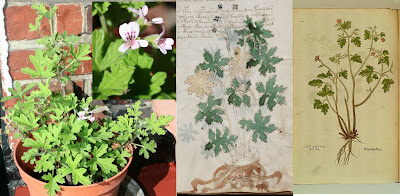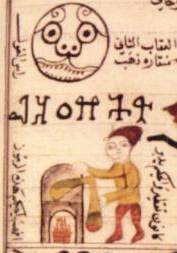When the Voynich Manuscript misdecipherer William Romaine Newbold died, his friend & colleague Roland Grubb Kent decided to bring all his late friend’s notes together into a book: this was published in 1928 by the University of Philadelphia Press under the title “The Cipher of Roger Bacon”. If you’d like your own copy, Kessinger sell a modern print-on-demand reproduction of it, with quite reasonable quality pictures (apart from the awful picture of Newbold right at the start).
And it was from Newbold’s and Kent’s book that the story of the modern missing pages sprang.
You see, there’s an innocuous-looking table in page 45’s footnote 2 that describes the physical make-up of the manuscript: in particular, it lists the first (what we would now call the “Herbal”) section (“Part I. Botanical, ff. 1-11, 13-66″) as having 65 folios (“leaves”), with 125 drawings and 5 text-only pages.
However, the manuscript as now owned by the Beinecke only has 59 leaves: Rene Zandbergen’s page on this lists folios 12, 59, 60, 61, 62, 63, and 64 as missing. Might folios 59 to 64 (at the centre of a quire) have gone missing in the 20th century, sometime between Newbold examining them and being given to the Beinecke by Hans Kraus? If so, might Newbold have had any reproductions of them?
While researching my book, en route to New Haven I stayed with some old friends near Philadelphia: and so used the opportunity to drop by the University of Pennsylvania’s archives, which I happened to know held several boxes of Newbold’s records. At last, I thought, I would be able to see if these missing pages might be there.
The good news was that the set of photostats Wilfrid Voynich had given Newbold were still there: yet the reproduction of the Herbal section contained precisely the same pages as we see nowadays – the same pages that are missing now were missing then.
So what actually happened? Simply, I’m reasonably sure that the table on page 45 was miscopied from an intermediate handwritten count, and that Newbold or Kent (whichever of the two) just got it wrong. The missing folios were long gone, decades (probably centuries) before Wilfrid Voynich bought it in 1912.
I suspect that the folio numbers were added between 1580 and 1600, around the time that the manuscript was rebound into its current order and repainted (probably to gain a higher price): and that many (if not all) of the missing pages-as-numbered were sent by George Baresch to Athanasius Kircher, as per the correspondence.
Perhaps Kircher’s collection of cipher notes will turn up one day (which would be very nice), and will turn out to contain many/all of these missing pages: but perhaps it is safer to assume that somewhere along the way, some well-meaning Jesuit administrator destroyed them – after all, something you can’t read surely has no value?



